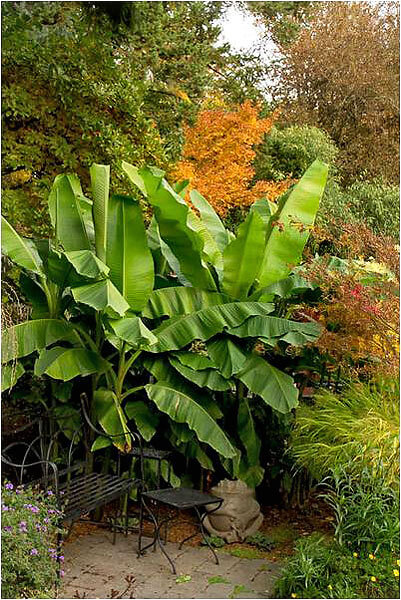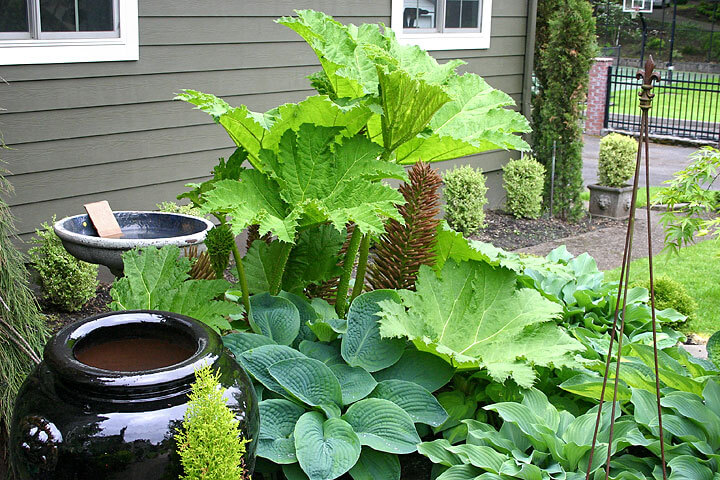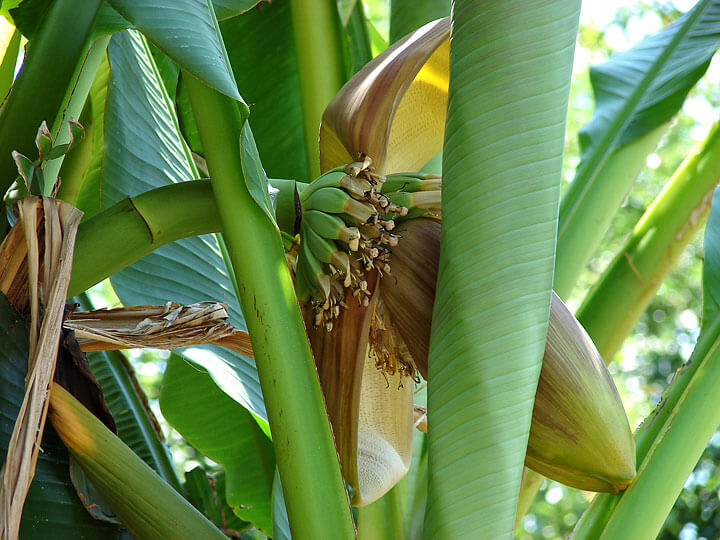It can be a bit difficult to shift gears and start thinking about winterizing plants, especially after we had such a dry and warm late summer and fall here in the Pacific Northwest. Recently we have had some rain but here it is mid-November and I have not had a frost at my house. Summer blooming plants have slowed down and do not look as good as they do in the summer, but overall, there are many semi-tropical plants that are still looking quite good. I have a large Canna in a pot on my deck and it is still in bloom. The Heliotrope has flowers and Begonia ‘Bonfire’ still has enough flowers to attract hummingbirds.
 Overwintering Hardy Banana
Overwintering Hardy Banana
However, we all know the mild weather is not going to last forever, and so now is a good time to discuss tips for winterizing plants. Soon we will be having regular frosts and temperatures below freezing and the tropical plants will be no more and the semi-tropical plants will need to have been put to bed for the winter. The Hardy Banana (Musa basjoo) is a very vigorous grower and even with the top growth dying to the ground in the winter; it can still reach 12-15 feet in height by the end of the summer. However, getting it to bloom can be quite a challenge.
This past summer I have been to several gardens to see Musa basjoo in bloom. The flower is large and quite unusual with a brown color and then behind the flower, small bananas will appear. Musa basjoo is native to a group of islands off the coast of Japan and it is referred to there as a fiber banana. This means that even if we had weather warm enough for the bananas to mature, it would not be considered an edible banana.
To increase the chance of plants having flowers, it is probably necessary to wrap the stems to protect them from the cold. I actually did this on three of my thickest stemmed plants and the wrap kept the stems from freezing. In the spring, the banana will then begin sending out new leaves at the tip of the stem. On the three stems I selected, I cut off the tops at about the six-foot level. I used bubble wrap and tied it around the stems and then wrapped burlap over the bubble wrap to protect the stems from being burned by the sun. Burlap also makes the wrap aesthetically pleasing.
In the spring, I removed the wrapping and the bananas started sending out leaves at the six foot level and the plants grew much taller than if the stems had died to the ground. Even though the roots are considered hardy, I like to give them the added protection of a thick layer of Black Gold Garden Compost Blend and on top of that I make several layers of the banana leaves I have removed. The leaves give some additional protection from the cold and also serve the purpose of preventing the soil conditioner from blowing away. The photo of the bananas is from my garden and this is all just the growth through mid-August.
The overwintering of the Musa basjoo may seem rather extreme and if you do not care if you have flowers, cut the stems to the ground after a hard freeze, add a layer of Black Gold Garden Compost Blend and layer the leaves you have cut off and your plant should survive just fine.
 Overwintering Gunnera
Overwintering Gunnera
Gunnera is a spectacular plant that also likes some winter protection. Since it likes lots of moisture, add Black Gold Just Coir and mix with existing soil when planting. Coir is actually coconut pith and is a natural and renewable product with superb water retention qualities. The crown of Gunnera can be tender to cold temperatures and I cut off the huge leaves and place them over the crown for winter protection.
Other Late-Season Plants of Interest
Another plant we can easily grow here but is not common in gardens is the hardy hibiscus (Hibiscus moscheutos). I think the word ‘hibiscus’ makes people think it is the tropical plant from Southern California and Hawaii, but it is very different except for the flower. The hardy hibiscus flower has the typical hibiscus flower shape and in some cases is even larger. Many times I have seen the hardy hibiscus with flowers the size of dinner plates and they come in a variety of colors. The hardy hibiscus will die to the ground but reappear in the spring with new stems. I like to add a layer of compost similar to what I do with the hardy banana. Hardy hibiscus is a great plant for a full sun location and it tends to bloom late in the summer, usually not until August.
We should never forget the wonderful winter color some plants can provide with just the bark or stems. Paperbark maple (Acer griseum) is a great example. This tree looks nice at any time of year but once the leaves drop, the trunk and stems are exposed and it is easy to understand how it got the common name of Paperbark Maple. A bonus in addition to the bark is that the foliage turns red in the fall. I have seen Acer griseum used as a tree for street plantings and it looks nice all year and is very easy to care for.
There are probably many other gardeners that have some tender plants in pots that they like to overwinter. I have more than I should! I have had good success with a tender Podocarpus and several citrus trees in pots just by putting them on a cart with wheels and bring them into the garage on nights when temperatures are expected to go below freezing. Then during the day, once temperatures have gotten above freezing, I wheel them out into the sunlight.
Just because we do not live in a tropical climate, with some extra effort we can push the zone!


